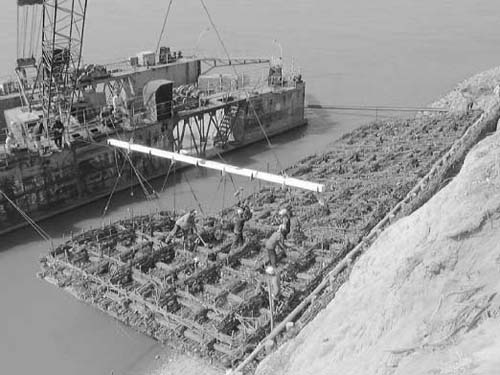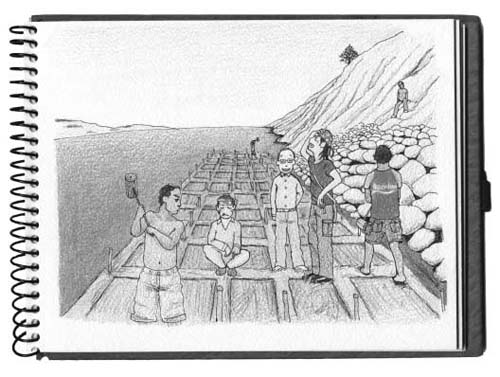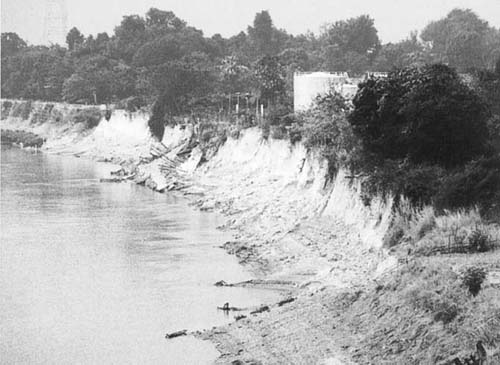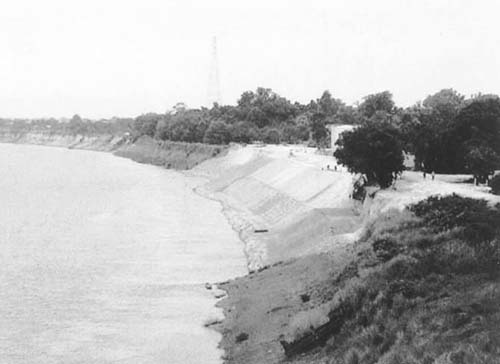Japan's Official Development Assistance White Paper 2006
Column II-3 The Project on Mekong Riverbank Protection Works with the Use of Japanese Traditional Methods
The Mekong River runs north to south across Laos and provides fertile soil to the lands along the stream, creating an abundant grain belt on the plain region of the country. On the other hand, the river swells drastically during the rainy season, with its water level rising more than 10 meters. Raging flows erode the river banks, bringing massive damage to the capital Vientiane by eroding properties and devastating houses, electricity supply lines, and other assets. The Government of Laos has been implementing countermeasures for river erosion since the 1990s. However, these measures involved costly imported equipment to facilitate bank protection. With limited budgets, sufficient effects failed to be realized.

Installation of fascine mattresses in the Mekong River (Photo: the Ministry of Land, Infrastructure and Transport)
In response to the request by the Government of Laos, Japan began a study to plan countermeasures for erosion of the Mekong River banks in and around Vientiane in 2001, then master-planned for river bank protection along with Laos. In the study Japan suggested its traditional river bank protection skills, such as one which uses fascine mattresses. The fascine mattress method was introduced in Japan in the late 19th century by Dutch engineers and applied to major rivers such as the Yodo, Kiso, Tone, and Shinano Rivers. The method uses branches of ordinary wood collected in mountains near villages. These branches are woven into mats and sunk down to the river bottom. Through the use of locally available materials, this method realizes large-scale river bank protection with low costs. Moreover, the created mats, with their various different shapes of slits among the woven branches, can provide habitats for aquatic organisms such as small fish and bottom animals. The method thus works in an environmentally-friendly way.

A construction site along the Mekong River was visited by Japanese actor Mr.Tomohiro Sekiguchi to shoot "Tomohiro Sekiguchi's Earth Supporter," a popular TV program hosted by him. (Mr. Sekiguchi drew this sketch)
The Government of Laos is implementing river bank protection projects based on the master plan that involves the method outlined above with funds procured from the national budget. In line with this initiative, in January 2005 Japan began a cooperation project to offer technical assistance for the diffusion of traditional Japanese river bank protection methods such as the one using fascine mattresses. As a result of the progress of river bank protection measures assisted by Japan, plants recovered within three years on river banks that were once eroded into bare cliffs, changing the landscape to lush slopes. Once scaring away people as dangerous sites, the banks now attract children to play and anglers to fish.
The traditional Japanese river bank protection methods have not only been adopted in public work, but also introduced at the department of engineering, the National University of Laos as part of the lectures on river engineering taught by local specialists who have received instruction and training from Japanese personnel. In this way the methods have become widely known in the country.


A scene of the Mekong River, significantly improved by the fascine mattress method (Photo: Hokuriku Soda Business Promotion Association)


 Next Page
Next Page